Migrate Etsy to Shopify: Benefits, Methods, Costs, and Solutions
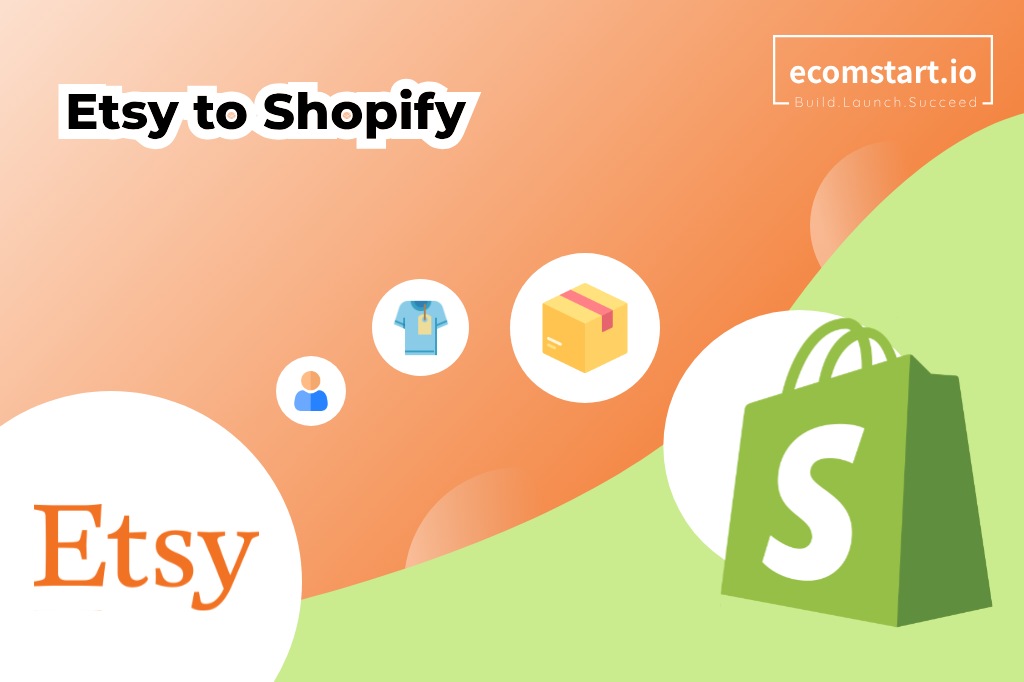
Want to have your brand and expand your business after running a store on the Etsy marketplace? Running a new store with Shopify is a great option, because of its various built-in features, diverse app ecosystem, and user-friendliness. However, moving from Etsy to Shopify is not easy, especially if you have a large database.
To help you avoid mistakes when you migrate from Etsy to Shopify, we will walk you through the process of how to transfer Etsy listings to Shopify, common mistakes you may get, and useful advice to help you avoid risks!
1. What’s Etsy to Shopify migration?
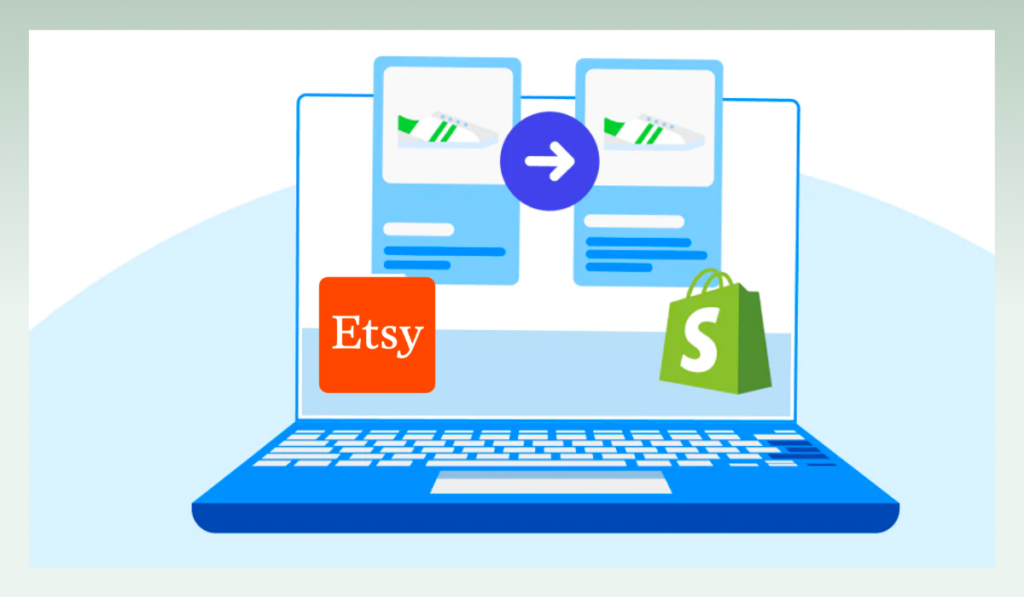
Etsy to Shopify migration refers to the process of moving your online store from Etsy, an eCommerce marketplace allowing merchants to sell their products, to Shopify, a powerful eCommerce platform that helps you build your website for your brand.
When moving from Etsy to Shopify platform, store owners have to create a new Shopify store and move all data from the Etsy store, including product listings, customer information, orders, reviews, and maybe other elements to the new one.
- Products: Product names, categories, photos, descriptions, and the quantity of stock of each variety.
- Product information: Cost, SKUs, and weights to ensure accurate shipping calculations.
- Customer information: Order history, email addresses, and names.
- Orders: Details to fulfill existing purchases.
You can migrate your store from Etsy to Shopify by using third-party migration apps, manually importing through CSV files, or hiring a migration team. To choose the migration methods, you should consider your budget, level of technical skill, and the complexity of your shop. If you have a large database and no technology knowledge, using the migration service is a good idea.
2. Why merchants should move from Etsy to Shopify
2.1. Easy to grow business

Thanks to built-in features and a diverse app ecosystem, Shopify allows merchants to expand product variants and types, reach more customers, and increase sales volume.
With Shopify, merchants can expand and classify various product categories, manage inventory by themself, and target more markets in different countries and areas without coding anything or hiring a development team to create new features for your store.
2.2. Create and manage brand identity
There are differences when you start a business on Etsy vs Shopify. When you run a store on the Etsy marketplace, you have to rely on the Etsy marketplace and its algorithm. You cannot edit your online store on the Etsy marketplace to showcase the brand characteristics.
On the other hand, Shopify allows you to create and manage your online store and brand identity. With Shopify, you can design your website as you want, establish a unique identity, cultivate a distinct brand image, and choose suitable marketing methods to approach your target customers. Not only that, having a branded online store can help you reach more customers in different countries, outside the USA.
2.3. Customize your store easily
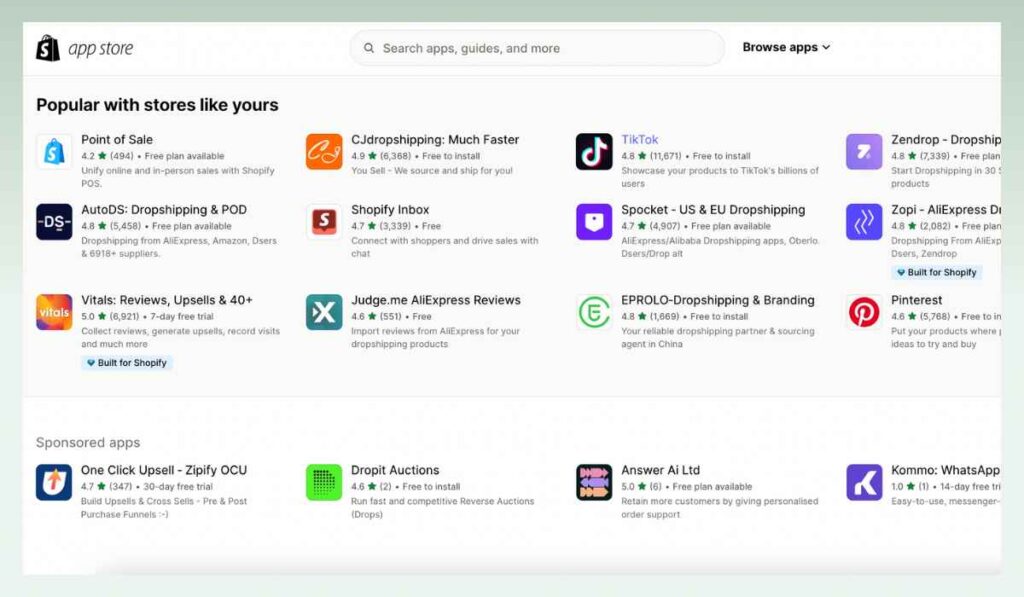
When comparing Etsy with Shopify, you can see that Shopify offers a higher degree of customization.
You can choose any stunning Shopify theme that fits with your brand identity, customize your website preference with built-in features in Shopify themes, and add any third-party apps to have more features you want. This customization capability allows merchants to tailor the shopping experience, combine necessary features, and create a unique brand.
3. Etsy to Shopify migration checklist
By following the checklist below, you can switch from WooCommerce to Shopify smoothly and successfully:
3.1. Before migrating
- Choose suitable migration methods: CSV files, apps, or hiring service
- Set realistic expectations for how long it will take and plan for some common challenges.
- Inform your customers about coming migration.
3.2. During migration
Data
- Backup your Etsy data
- Export data from Etsy about products, customers, orders, and policies.
- Check, adjust, and clean up your data
Shopify store setup
- Create a Shopify account after selecting a plan.
- Based on your target audience, business plan, and budget, select an appropriate theme.
- Install the programs that are required for your store.
Migration
- Move your data by the guidelines provided by the migration technique you choose.
- Add suitable Shopify apps that you need
- Test the product pages, checkout process, payment methods, and delivery of your store.
3.3. After migrating
- Update your marketing materials by changing any links or references to your previous ones.
- Testing your store to make sure that the store runs well without mistakes.
- Manage your store performance.
4. How much does it cost to migrate from Etsy to Shopify?
When you migrate data from Etsy to Shopify, you have to pay Shopify subscription fees, data migration costs, and setup costs. The cost is based on the migration methods, Shopify plan, and theme you choose.
4.1. Shopify subscription and apps
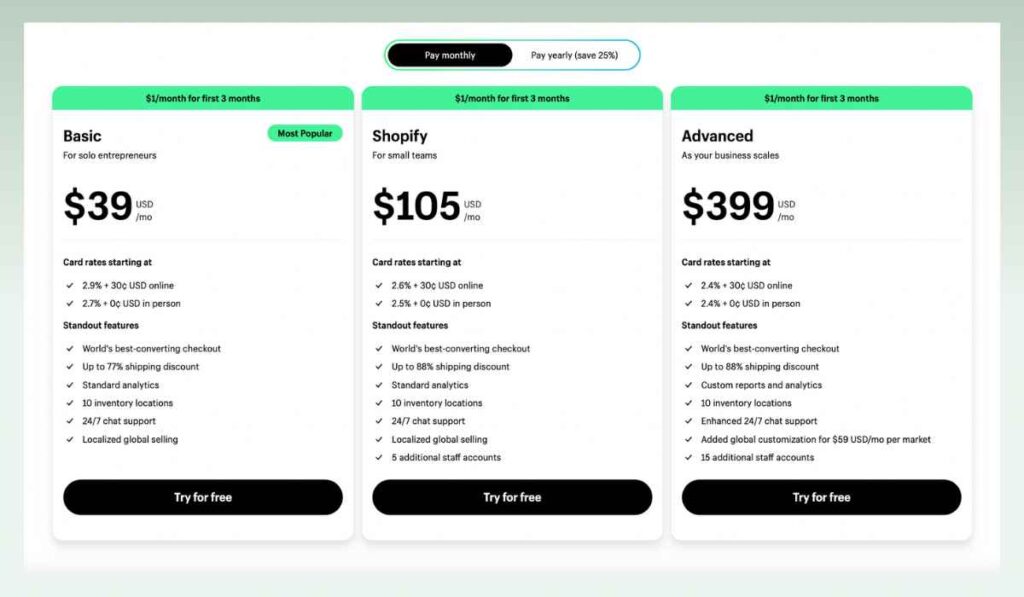
When moving from Etsy to Shopify, you have to create a new Shopify online store and choose a suitable subscription plan for your business. There are four plans that Shopify offers:
| Subscription | Pricing | Best for |
| Basic Plan | $39/ month (25% off on yearly payment) | Individuals and small stores |
| Shopify Plan | $105 per month (25% off on yearly payment) | Small stores and businesses |
| Advanced Plan | $399 per month (25% off on yearly payment) | Medium to large stores and businesses |
| Shopify Plus | Starting from $2000/month | Enterprises |
4.2. Data migration
The most crucial and complicated of this process is data transfer. At this stage, you will import data from Etsy to Shopify store. The cost of data migration based on the methods you choose:
- Manual method (Free)
If you don’t have a large database, this method is for you. And of course, it is totally free. With this method, you will export data from Etsy in CSV format and manually import it to the Shopify store.
- Third-party migration apps ($49/month – $100/month)
If you want to save time, you can use migration apps. These apps provide data migration features, including mapping, conflict resolution, and post-migration support.
- Hiring Shopify expert ($500- $4,000+)
Hiring Shopify experts is expensive, however, it is suitable for any store that has a large database and cannot handle it. The team will manage the whole migration process for you and make sure that the data will be transferred fast and accurately.
4.3. Design and set up new Shopify store
When you finish the data migration process, your store is plain without any features. You have to choose a suitable and stunning Shopify theme to design your store and add some apps. Merchants have to pay for the Shopify theme, from $0 to $350, and apps, around $20/month.
If want to customize your apps and store and don’t have any knowledge about UI/UX or coding, hiring an expert team is a great solution. However, the cost is high, from $500 to $25,000, based on your requirement.
5. What data you can migrate from Etsy to Shopify
When you migrate data from Etsy to Shopify, you can transfer some types of data by manual methods or using any apps and services. Here’s a breakdown:
| Data Elements | Data |
| Product Information | – Product titles – Descriptions – Prices – Variants (sizes, colors, etc.) – Images – SKU (Stock Keeping Unit) information – Reviews |
| Inventory Details | – Stock levels – Available quantities – Order history – Inventory level |
| Customer Information | – Customer names – Email addresses – Shipping addresses |
| Order Data | – Order details – Order status – Shipping information |
| SEO Settings | – Product tags – Meta descriptions – URLs |
| Payment and Pricing Settings | – Payment methods – Currency settings – Tax information |
| Shop Settings | – Shop policies – Customizations and settings |
6. What data you cannot migrate from Etsy to Shopify
When you migrate data from Etsy to Shopify, you cannot transfer all data because of platform differences. Here’s a breakdown:
- Etsy-specific features: Download feature for digital products (customers can download digital products on Etsy stores), Etsy conversation, shop updates, Etsy shop sections.
- Product categories and tags
- Customer passwords
- Etsy shop announcement
- Etsy listing renewal and expiry data
- Promotions and coupons
7. How to move from Etsy to Shopify
7.1. Decide on your migration method
Before migrating data to your Shopify store, you have to choose a suitable migration method based on your budget and the database size. There are three methods that you can choose to migrate data: manual migration with the CSV file, using third-party migration apps, or hiring an expert team.
In this blog, we will show you how to migrate data to Shopify through CSV files. This is the common method that most merchants use.
7.2. Create a Shopify account

When moving from Etsy to Shopify, you have to create a new Shopify account to create a new store and move Etsy data to it. To choose an appropriate Shopify plan, you have to consider your budget, short-term and long-term goals, and the business size. If you are a small business that has a small budget, starting with the Shopify basic plan is a good idea.
7.3. Export data from Etsy
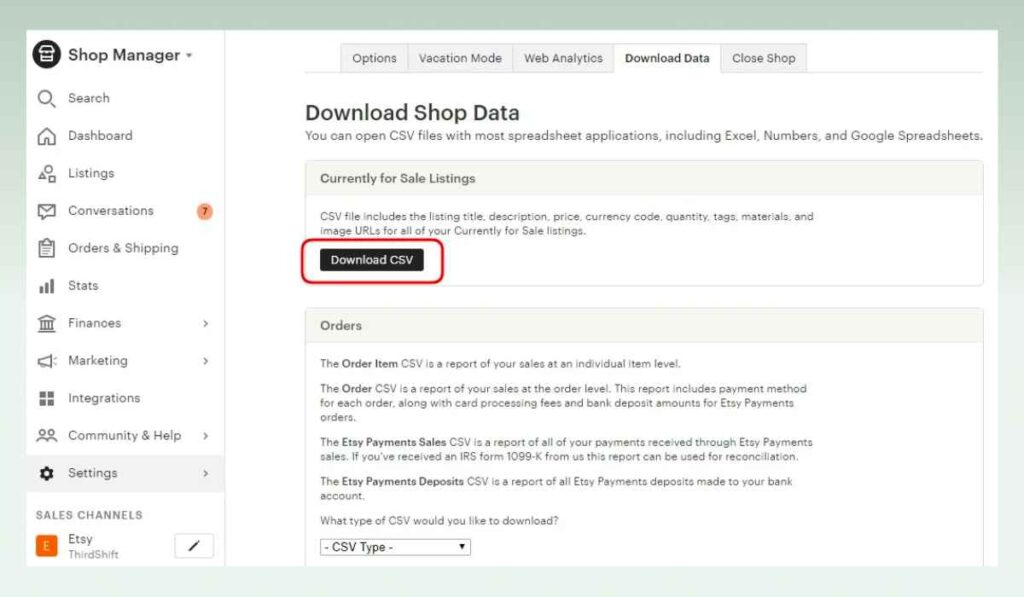
In this step, you will export all data relating to products, customers, and orders from your Etsy store. There are two steps to export Etsy data:
- Log in to your Etsy account and access the Etsy seller dashboard. Go to Shop Manager choose Settings and choose Options.
- Choose Download Data, and pick up the data you want to export, including listings, orders, and other relevant information.
Finally, you will have CSV files containing important data to import into your new Shopify store.
7.4. Import data from Etsy to Shopify
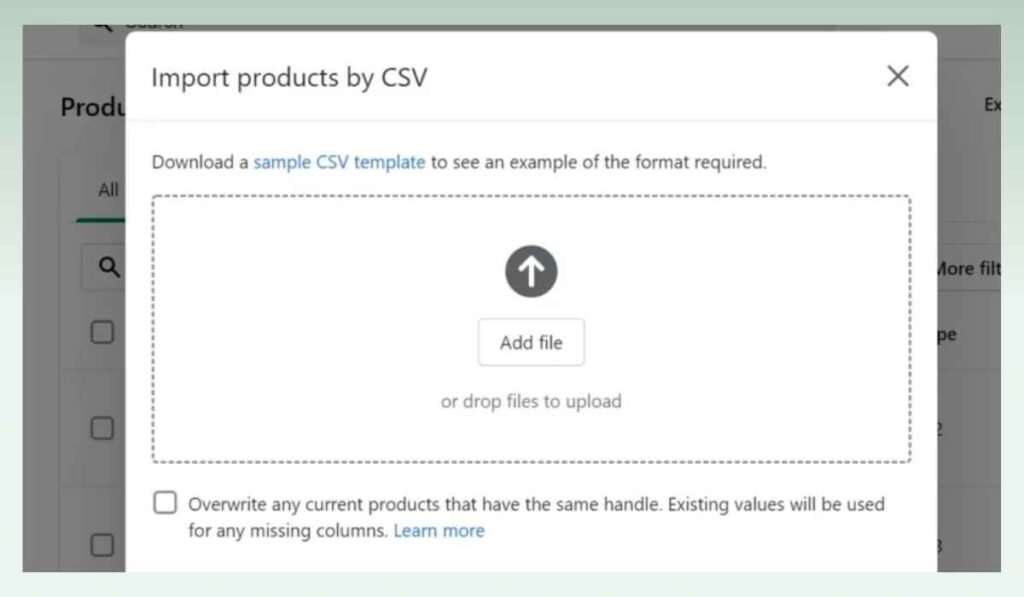
After exporting them to CSV files, you need to revise and check the data again to ensure it is correct. When importing products from Etsy to Shopify, you need to include both the orders and the order items files to have a successful transfer process.
- In your Shopify admin, go to Apps and choose Store Importer.
- On the Import your data into Shopify page, choose Etsy from the drop-down menu
- Click Add file in the Upload files section and choose the exported Etsy files.
- Continue from Importing to Import.
Click Select a different platform at the bottom of the page if the platform that appears on the Store Importer page isn’t the one for your shop. Next, select Etsy from the drop-down menu.
7.5. Review and update your imported data
There are some data like product variants and customer reviews that you cannot transfer directly. You have to use third-party apps or hire a Shopify expert team to do it for you. Based on your budget, you can choose a suitable solution.
After migrating all data to the Shopify store, review and check all of the imported data to find any missing components. If there are any mistakes, you have to import and adjust manually.
7.6. Design and set up your Shopify store

After moving from Etsy to Shopify, your store is plain and boring. That is why you have to complete it by choosing a suitable theme and customizing the theme as you want to fit with your brand identity.
To meet your business’s needs, you need to change the payment gateways, shipping, taxes, and other options in your store. Moreover, installing the required applications for your shop is an essential step to function properly. On the Shopify app marketplace, you may select appropriate pricing options and browse applications and extensions.
7.7. Test and launch your Shopify store
To avoid the mistake before publishing your store, you have to thoroughly test and make sure that all data has been transferred accurately and the store runs well. Product pages, cart functionality, checkout process, and app functions are elements you need to check.
Besides, don’t forget the SEO of your store. Because this is a new store, you have to make sure that all SEO elements including alt text, image size, and content on your page are optimized. After checking your store, you can publish your Shopify store and run it as a new sales channel.
7.8. Inform customers about your new Shopify store
After publishing your store, you need to inform your customers about the new store via social media, email, and SMS. Besides, if you still keep your Etsy online store, you can leverage your Etsy online store to announce your new website. This will help you to gain more traffic and attract customers.
8. Tips for smooth migration
8.1. Focus on data cleaning and preparation

Before importing the data to your Shopify store, you need to check again the data accuracy and adjust the data to fit with the Shopify format. You can avoid issues and save time by correcting errors manually after importing data to your new store.
8.2. Back up data regularly
To avoid the mistake, you should back up your data on both Etsy and Shopify regularly during the migration process. Don’t forget to keep copies of important data like product listings, customers, and order information. They can help you recover data quickly in case of any unexpected problems during the migration process.
8.3. Create a checklist
If you are worried about missing any data and steps, having a detailed checklist is a great solution. There are various checklists you can find on trustworthy resources like the Shopify support page, the IT forums, or our blog! If you hire an expert team to migrate data for you, make sure that they give you the checklist to keep track of the migration process and ensure the project is on time.
9. Some errors and solutions
9.1. Missing or broken images
When moving data from Etsy to Shopify, As you can see, there are a few photos that might not appear correctly after the migration due to broken links or incorrect URLs. Checking the picture URLs in your WooCommerce CSV file is therefore necessary. You must manually change the URLs and fill out the missing photos in the Shopify store if there are any missing images.
9.2. Inaccurate data in product variants
As we mentioned above, you cannot migrate product option data from Etsy to Shopify directly. That is why you have to manually add it to the Shopify store or use third-party apps to transfer this data automatically.
In the migration process, there are some errors due to data inaccuracy and incompatible Shopify data format. Thus, merchants have to review data and adjust the data to fit with Shopify format
9.3. Missing some customer information
If you have multiple consumers with the same email address or phone number, you may face up with missed customer data. Thus, you will need to enter the earlier customer data manually because just the most current item with duplicate data is imported.
10. Conclusion
Moving from Etsy to Shopify can help you to establish and control your brand and expand your business. To avoid common mistakes and make sure that your store is migrated on time, you have to carefully plan for your migration process, back up data, create a checklist, and check your data thoroughly.
If you want to gain more valuable and practical eCommerce knowledge, just subscribe and check out our blog! eComStart will provide remarkable solutions to avoid risks, leverage your resources to stand out of the crowd in the market, and drive success!


